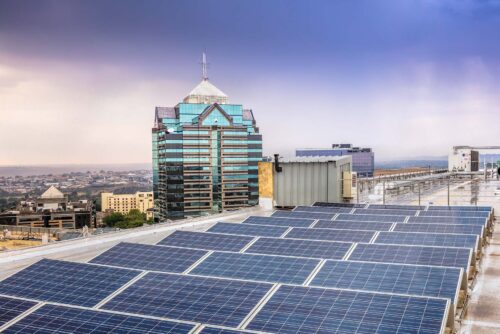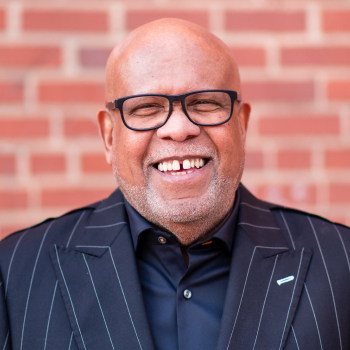
A Multi-Billion Dollar EPA Fund Is Delivering the Energy Transition to Overlooked Communities
Here’s how to make the EPA’s $27 billion Greenhouse Gas Reduction Fund work harder toward an equitable energy transition.
The United States is on a one-way track to a fossil-free real economy. Fossil fuel demand has peaked in key sectors. Billions of net-zero dollars have been committed by both private and public capital, supercharged in the wake of the Inflation Reduction Act (IRA). Clean technology shifts are happening at a breakneck pace and rapidly increasing scale.
But the energy transition has a serious market failure to contend with. Although clean energy solutions like rooftop solar and heat pumps offer consumers significant savings over time, high upfront costs and long payoff periods make them low priorities for small businesses and low- and middle-income households facing more urgent financing needs. We need to finance the energy transition in all communities, but not all communities and businesses benefit from affordable access to mainstream finance.
Community lenders have been diligently finding ways to get capital to communities and businesses neglected by mainstream finance for decades. Fortunately, the Greenhouse Gas Reduction Fund (GGRF), a $27 billion program from the Environmental Protection Agency (EPA), is designed to leverage this network and expertise, fostering a movement that makes the energy transition real for Main Street communities, creates jobs, and positions local economies to materially benefit from decarbonization.
RMI is working to support robust applications to GGRF funding competitions, and we are partnering with critical stakeholders to explore creative ways to raise the bar on program implementation and identify practicable solutions to ensure success.

We need to work hand in hand to capitalize and equip BIPOC-led organizations, as they are deeply rooted, with a proven track record, in and dedicated to serving the communities most affected by climate change. Maximizing the potential of the Greenhouse Gas Reduction Fund for the neglected communities we represent is a crucial step in this journey.
Lenwood V. Long, Sr.
Lenwood V. Long, Sr., President and CEO of the African American Alliance of CDFI CEOs which leads the Community Builders of Color Coalition, a national network representing over 1,200 community-based financial institutions, and an RMI partner in better accessing the GGRF.
Below are a few key impacts we hope GGRF can achieve, and a few things we think can make this program most successful.
3 Ways to Increase GGRF’s Impact
1. Tap into other private and public funding sources
GGRF’s $27 billion is a windfall for communities that historically face underinvestment from private finance, but it is also a key that can unlock greater capital supply when deployed strategically. By tapping into other public and private sources of funding, GGRF dollars could mobilize upwards of $250 billion over 10 years.
The IRA is estimated to include upwards of $390 billion in incentives for energy and climate investments. Targeting GGRF funds toward investment opportunities that leverage these and other clean energy incentives can serve to significantly stretch the impact of GGRF dollars. By stacking or blending with other public funding incentives, GGRF applicants can boost investment strategies, improving product interest rates and making applications more competitive. For example, new direct pay guidance may present a huge opportunity for non-taxable entities to monetize tax credits, accelerating the recycling of funds.
Meanwhile, Wall Street financial institutions with $64 trillion in assets under management have committed to reaching net-zero by 2050. The supply of capital theoretically ready to mobilize for climate investments is immense, but many high-priority financing needs do not match the risk-return or deal size requirements of large banks and investors. By providing finance where markets otherwise wouldn’t, and by identifying ways to standardize and aggregate bespoke and smaller deals, GGRF recipients can serve as critical bridges to bankability, unlocking capital at scale toward an equitable energy transition.
2. Prioritize financing solutions that build shared and lasting wealth
GGRF is one of the largest climate investments in low-income and historically disadvantaged communities to date. These funds can have the greatest impact in facilitating broad wealth creation from a net-zero transition by improving long-term access to affordable capital. To achieve that, we may need to take a radically different approach to investing in underserved markets.
Traditionally, “credit enhancement” products like loan guarantees or subordinated debt work by protecting the lender from risk, rather than enhancing the borrower’s long-term credit. Put another way, these tools don’t address the underlying risk drivers that initially impede investment, and therefore don’t improve the borrower’s future ability to access affordable debt without concessional support. Meanwhile, overreliance on debt financing can harm borrower credit scores and balance sheet solvency. We believe there is a role for creative approaches and products to transform markets by building credit, rather than providing band-aid solutions to enable one-time financing that uses credit up.
For instance, can insurance-like products help overcome challenges to siting renewable generation assets by mitigating potential downside risk to surrounding property values? Can national diversification of risks across coalitions of community lenders be leveraged to achieve lower rates? Can repayment risks be mitigated by more closely tying loan products to energy use?
3. Recognize the work of community-based lenders as central to the energy transition
Community development financial institutions (CDFIs) and credit unions are increasingly extending green lending products and upskilling on green finance. Over 500 credit unions, community banks, and CDFIs offer green loan products today, and many more are in the process of developing green products and programs. GGRF can build on and accelerate this progress, but it should also be seen as a steppingstone to a more expansive role for community lenders in the energy transition.
The United States has clear intentions and momentum to reach net-zero emissions by decarbonizing the electricity, transportation, and buildings sectors, and we know that the last consumers to transition away from fossil fuel-reliant homes and cars will face the highest costs as green alternatives gain market share across the country. If we don’t embrace a different approach, the energy transition risks exacerbating the immense and unacceptable US wealth gap.
CDFIs have a demonstrated track record as financial first responders in underserved communities. The urgency of finding ways to deliver decarbonization outcomes across entire portfolios and communities looms larger than climate goals. It is about capitalizing on an inevitable energy transition to uplift homes, communities, and businesses, and build lasting wealth along the way to net-zero.
Seizing the moment to finance an equitable energy transition
Achieving a net-zero transition in all US communities will require prioritizing investment in places where affordable finance is typically least available, and doing so in a way that drives economic development, provides demonstrable impact and benefit to communities, and leaves those places better off.
A once-in-a-generation opportunity calls for an unprecedented response. Realizing optimal benefits from the GGRF will require bold coordination across diverse stakeholders and a commitment to re-envisioning our nation’s collective approach to financing economic resilience and revival. RMI is committed to equipping critical GGRF stakeholders with the capacity, resources, and technical advisory and support systems to place communities in the driver’s seat of their transition and capitalize on the moment.
For more information on our GGRF work, or to get involved, please reach out to our team.